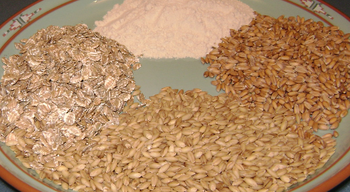 |
| English: Fried gluten balls. Photo by ChildofMidnight. Attribution required. (Photo credit: Wikipedia) |
 |
| Photograph of 4 gluten sources. Top: High-gluten wheat flour. Right: European spelt. Bottom: Barley. Left: Rolled rye flakes. (Photo credit: Wikipedia) |
Businesses are finding new ways to cash in as Americans open their wallets to get healthy. Foods that are naturally gluten-free – like popcorn and nuts – now advertise that on their packaging. Although only about 6 percent of the population has gluten sensitivity, some 30 percent of the public hopes to decrease the gluten in their diets, the market research company NPD Group said.
In the United States, sales of gluten- free products were about $10.5 billion last year, and they could reach more than $15 billion in annual sales in 2016, The Times reported.
“There are truly people out there who need gluten-free foods for health reasons, but they are not the majority of consumers who are driving this market,” Virginia Morris, vice president for consumer strategy and insights at Daymon Worldwide, told the Times.
“The reason I do believe this has legs is that it ties into this whole naked and ‘free from’ trend,” Ms. Morris added.” I think we as a country and as a globe will continue to be concerned about what’s going into our food supply.”
For those who can afford classes like a $900-a-month stomach-toning workout with a broomstick, the website Well+Good updates its audience on how to live the healthy life in New York.
Its coverage includes articles like the recent one on a brand of chia seeds that costs four times more than apparently lower-end chia seeds. Gym classes featured on the site are quickly filled.
One fitness regimen gaining popularity is Piloxing: part Pilates, part boxing and a bit of dance. Created by a former jazz dancer, Piloxing is praised for its dynamic approach. But its interpretation of Joseph Pilate’s namesake routine is criticized by purists.
----------
RESERVE for a healthier you!
----------
“There’s no mind-body connection whatsoever,” Jennifer De Luca, owner of the Body Tonic Pilates studio in New York, told The Times.
“I’m sure what she’s doing creates really tight butts, and a lot of people want tight butts, but to call it Pilates is a stretch.”
Yet Piloxing is taught by 7,000 instructors in 36 countries.Melisse Gelula, a founder of Well+Good, said fitness and wellness movements are becoming more accessible instead of available only at destination spas.
“Now all of this stuff – energy treatments, juice bar, spin – is part of your daily life, instead of something you go away to do,” Ms. Gelula told The Times.
Monitoring your activity can be routine as well, if you have $100 or so to spare. Activity trackers keep a record of calories burned and hours slept, and more expensive models can monitor heart rate and skin temperature.
“Makers of the devices have begun intensive campaigns aimed at convincing the large population of ‘worried well’ consumers to get wired and start recording their every move,” Albert Sun wrote in The Times after testing several of these activity trackers.
Activity trackers generated $290 million in 2013 sales, The Times reported, and sales could double in 2014.
The trackers might not be entirely accurate – Mr. Sun’s wrist-worn trackers did not recognize his leg tapping to music or his time on an exercise bicycle – but they offer other benefits.
Dr. Rajani Larocca, a physician at Massachusetts General Hospital, conducted a study last year examining lifestyle changes that encouraged healthful eating and exercise. Each participant wore a Fitbit Zip monitor, which provided extra motivation.
“Every single person increased their activity,” Dr. Larocca said.
“People felt more knowledgeable.”
Taken from TODAY Saturday Edition, March 29, 2014







No comments:
Post a Comment